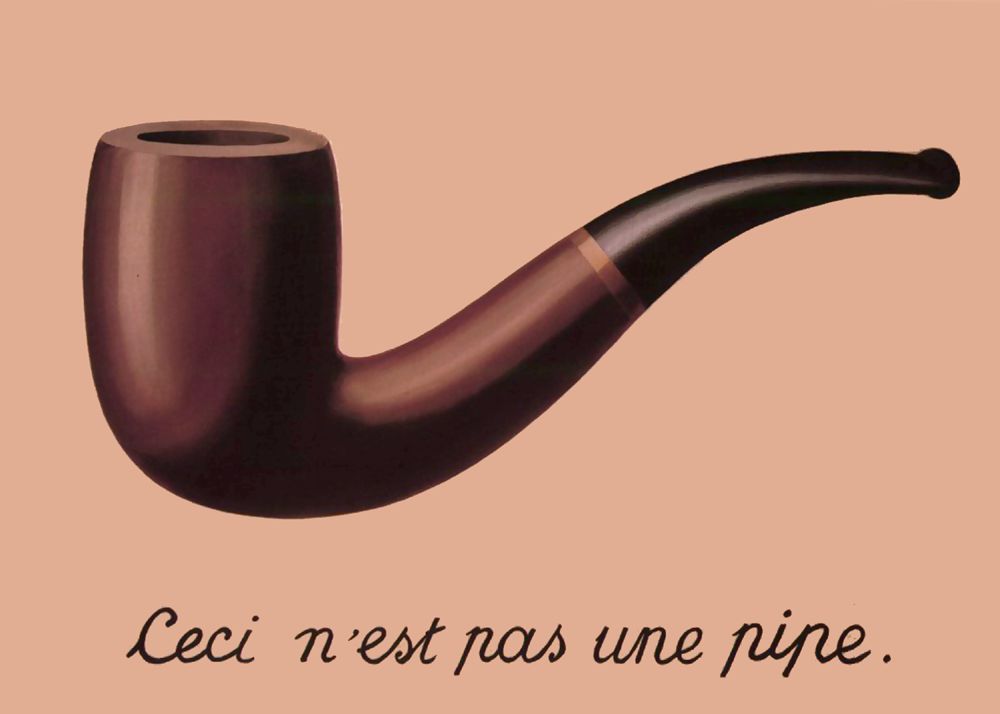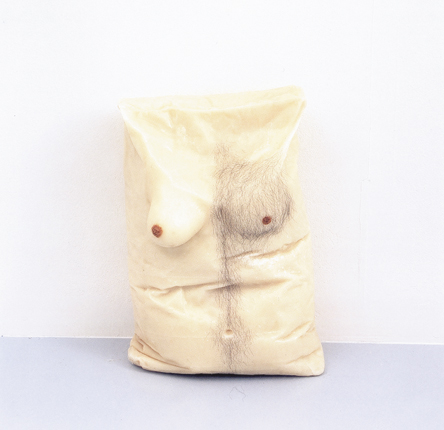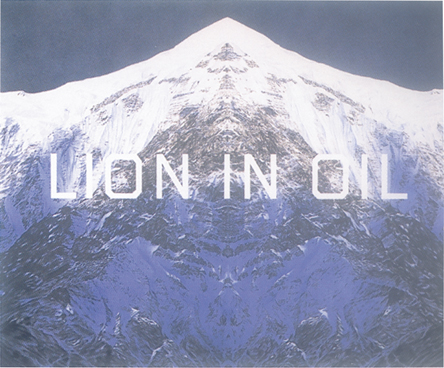
"This Is Not A Pipe" from The Treachery of Images
René Magritte, 1929
Oil on canvas
63.5 cm × 93.98 cm (25 in × 37 in)
Los Angeles County Museum of Art, Los Angeles, California
Hi,
The Treachery of Images (La trahison des images 1928–29) is a series of paintings by René Magritte, famous for its inscription Ceci n'est pas une pipe (French for "this is not a pipe"). The paintings are currently housed at the Los Angeles County Museum of Art (LACMA) in Los Angeles, California and at the Menil Collection in Houston, Texas.
The picture shows a pipe that looks as though it might come from a tobacco store advertisement. Magritte painted below the pipe: "Ceci n'est pas une pipe" (This is not a pipe), which seems false but is actually true. The painting is not a pipe, but rather an image of a pipe. As Magritte himself commented: "The famous pipe. How people reproached me for it! And yet, could you stuff my pipe? No, it’s just a representation, is it not? So if I had written on my picture ‘This is a pipe,’ I’d have been lying!" Magritte extends the style and effect in his 1930 painting The Key of Dreams.
Check out the article by Izabel I.S. Gass at the end of this blog.
Here's info about the 2007 exhibit in LA-Magritte and Contemporary Art: The Treachery of Images is the first major exhibition to explore the impact of Belgian surrealist artist René Magritte's (1898-1967) work on U.S. and European artists of the post-war generation. Featuring sixty-eight paintings and drawings by Magritte, including many international loans of his signature works, and sixty-eight works in diverse media by thirty-one contemporary artists such as Richard Artschwager, John Baldessari, Vija Celmins, Robert Gober, Jasper Johns, Jeff Koons, Ed Ruscha, and Andy Warhol, the exhibition examines the different and sometimes unconscious ways that pop, conceptual, and post-modern sensibilities have referenced Magritte's ideas and imagery. In addition, the exhibition installation is specially designed by conceptual artist John Baldessari and includes an inventive presentation that is playful and humorous, yet provides a deep visual understanding of Magritte's work. Magritte and Contemporary Art: The Treachery of Images is on view at LACMA from November 19, 2006, through March 4, 2007, and will not travel to other venues.
Co-curated by Stephanie Barron, LACMA Senior Curator of Modern Art, and Michel Draguet, Director of the Musées Royaux des Beaux-Arts de Belgique, with cooperation from the Magritte Foundation, Magritte and Contemporary Art: The Treachery of Images goes beyond overt analogies between the work of Magritte and contemporary artists to explore the more idiosyncratic and subtle connections of visual, thematic, and philosophical references. Looking at works in a range of media from a number of decades, the exhibition reveals the ways in which Magritte's visual vocabulary and artistic strategies have seeped into our culture, and demonstrates how his subversive juxtaposition of words and images, flat painting style, and constant exploration of perception have profoundly affected subsequent generations of artists. The exhibition features works by contemporary artists Eleanor Antin, Art and Language, Richard Artschwager, John Baldessari, Mel Bochner, Marcel Broodthaers, Vija Celmins, Robert Gober, Philip Guston, Douglas Huebler, Jasper Johns, Ray Johnson, Mike Kelley, Martin Kippenberger, Jeff Koons, Joseph Kosuth, Barbara Kruger, Sherrie Levine, Roy Lichtenstein, Claes Oldenburg, Raymond Pettibon, Sigmar Polke, Richard Prince, Robert Rauschenberg, Charles Ray, James Rosenquist, Ed Ruscha, David Salle, Jim Shaw, Andy Warhol, and Lawrence Weiner.
At the center of the exhibition is LACMA's Magritte masterpiece — The Treachery of Images (This Is Not a Pipe), (1929) — a seminal painting and popular cultural icon.
In popular culture
Countless other works of art or entertainment have made use of the phrase "Ceci n' est pas...", a translation, or a variation on the concept of the difference between an object and its image (or symbol), one example being The Simpsons couch gag for the season nineteen episode "That 90's Show" where The Simpsons are seated on the couch with the caption, "Ceci n'est pas une couch gag". "Ceci n'est pas une pipe" is also the name of a level in Lemmings 2 and in Neverball. It is also mentioned in the song "If not now, whenever" by "The Books".
Literary and cultural criticism
French literary critic and philosopher Michel Foucault discusses the painting and its paradox in his 1973 book, This is not a Pipe (English edition, 1991).
In Scott McCloud's Understanding Comics, the painting is used as an introduction to the second chapter. McCloud points out that, not only is the version that appears in his book not a pipe, it is actually several printed copies of a drawing of a painting of a pipe.
Douglas Hofstadter also discusses this painting and other images like it in his book Gödel, Escher, Bach: an Eternal Golden Braid, a treatise on formal systems and intelligence.
Magritte and Contemporary Art: The Treachery of Images
Los Angeles County Museum of Art
- Izabel I.S. Gass -
Magritte and Contemporary Art: The Treachery of Images, curated by John Baldessari, is a miscellany of iconic contemporary works interspersed with Belgian Surrealist René Magritte’s paintings. Like a baffling slide comparison exam, juxtaposed works require conceptual synthesis. In fact, Baldessari reported in many recent interviews that he curated the show with the pedagogical intent of asking viewers what Magritte’s relationship to contemporary art is. Playing the role of responsible pupil, the critic might venture that the very complexity of this art historical synthesis is its solution.
Just as contemporary art is a multifarious aggregation of objects, words and images indescribable by a singular essence, Magritte’s paintings espouse disunified representational strategies and subject matter. Such unrestricted artistic production descends from a common philosophical platform: what Magritte shares with contemporary art is a constructionist epistemology—the notion that categories of existence, such as male and female or art and non-art, are constructed or arbitrarily defined through socially prescribed customs and behaviors.
Constructionism opposes essentialism, the contention that categories of being are defined by eternal and universal essences. Magritte’s methodology pervades three levels of production, the first being subject matter, most saliently expressed in depictions of gender as a social construction—an interest shared by Barbara Kruger and Robert Gober. The second level is technique, as Magritte’s word-image paintings articulate the arbitrary relationship of language to the world reverberated in the contemporary by Ed Ruscha. The third aspect, historical significance, established by Magritte’s refusal for an essentialist definition of art, is echoed by conceptual artists such as Joseph Kosuth.
Constructionist depictions of gender are salient in contemporary art due to anti-essentialist Third Wave Feminism and Post-Structural gender studies led by theorist Judith Butler, who contends that gender is constituted by an individual’s active adherence to preexisting social norms rather than biological or temperamental characteristics. Kruger’s Untitled (It’s a small world but not if you have to clean it) features an obedient fifties housewife professing a relativist perspective on the value of domesticity. The ironic subversion of the title’s altruism reveals that, while men find comfort in the idea of a familial and intimate world, the archetype of such intimacy—the home—represents an overwhelming chore to the woman, who must literally perform her femininity by constantly laboring within a domestic sphere that is only a temporary refuge for male subjectivity.
While Kruger exposes “domestic bliss” as an ironically taxing imposition on feminine livelihood, Magritte’s The Titanic Days (1925) similarly portrays feminine docility as a cruelly imposed condition of life rather than an essential characteristic of the female psyche. The image of a male rapist is here superimposed on the image of a female nude (iconic of feminine subservience to male artistic authority), intimating that female passivity is a behavioral response to misogyny. Beyond merely exposing gender as constructed through social conditions, actually dismantling the binary categories of male and female is key to unraveling essentialist gender construction.
In this vein, Gober’s Untitled unites one half of a male and a female chest under a single blanket of waxy flesh, suggesting that even corporeal traits, such as nipples, navels and the wrinkled marring of aged skin, are not inherently sexually divided. Similarly, Magritte’s Elementary Cosmogony (1949) depicts a balustradelike inanimate object posed like a reclining nude with two human arms—one female and one male. In supplanting the expected corporeal with an architectural element and then confusing our ability to anthropomorphize it as distinctly male or female, Magritte outmaneuvers the essentialist binarism of gender.

Robert Gober, Untitled (Torso), 1990 Beeswax, human hair, pigment
24 1/4 x 17 x 11 inches
Collection of the artist>/p>
The assemblage of disparate visual elements in Elementary Cosmogony is representative of Magritte’s constructionist technique, stringing together images like words—and sometimes images with words—in a nonsensical syntax to create visual neologisms. This linguistic technique is especially prominent in Magritte’s so-called word-image paintings, in which visual images are paired with words in ways that question the culturally accepted relationship between language and images. The word-image paintings ultimately demonstrate that material objects (the signified) and the language or images that we use to represent them (the signifiers) do not share a particular essence but, rather, belong to distinct systems of logic and are only related through socially constructed associations.
To contrast this understanding of language with an essentialist viewpoint, German phenomenologist Martin Heidegger conversely held that every signifier shared a timeless, transcendent essence with the signified. Thus, for Heidegger, etymological inquiry revealed the purposive value of material objects, such as “home” or “technology.” Magritte turns such essentialism on its head with The Interpretation of Dreams (1935), which features images of everyday objects titled by words that do not describe them, such as the French word lune (moon) used to describe an image of a shoe. This arbitrarily reconstructed verbal/imagerial lexicon evinces that, in an alternate, oneiric state of logic, words and objects can acquire new relationships, as they are not transcendentally united.
Likewise, Magritte’s well-known painting for which the exhibit is titled, The Treachery of Images (1929), features an image of a pipe above a phrase translated as “this is not a pipe.” The painting establishes three distinct systems of logic—image, language and object—which must be actively paired and parsed to construct an intellectually ordered world. Ruscha’s Lion in Oil similarly distinguishes systems of representation from material objects: “Lion in Oil” is a palindrome, which signifies nothing outside itself but reaches a kind of meaning through internal logic—the arrangement of individual letters. While an essentialist would search for the transcendent qualities shared by a signifier and signified, such as the word and the animal ‘lion,’ Ruscha instead reveals that the word ‘lion’ belongs to a separate order of meaning distinct from the object it signifies, similar to Magritte’s pipe that is not a pipe.

Ed Ruscha, Lion in Oil, 2002
Acrylic on canvas
413 x 464 3/4 cm
Fisher Landau Center for Art
Magritte’s constructionist depictions of gender and language ultimately ally him with many conceptual artists featured in the show, none more so than with Joseph Kosuth, whose 1969 essay Art After Philosophy defined art through the tautological statement that every work of art created is itself the ever-expanding definition of art. Kosuth and his contemporaries rejected essentialist definitions of art as painterly, abstract or illusive, instead legitimizing anything an artist claims to be art. This constructionist notion of art as a social contract or public statement of authorship leads Kosuth to refuse formalist methodology in favor of linguistic presentations—communicative moments between artist and viewer such as his Definition (“Thing”).
While Marcel Duchamp is understood as the harbinger of Conceptualism for asserting that authorial intent is art, Magritte also offered something to this intellectual legacy. In maintaining legible representational strategies while upsetting traditional logic (as in his depictions of gender) and in using language to disrupt visual representation (as in his word-image paintings), Magritte dismantles both abstractive formalism and figurative narrativism from the inside out, reconstituting art as an act of unrestricted communication between artist and viewer—a constructionist triumph for art history